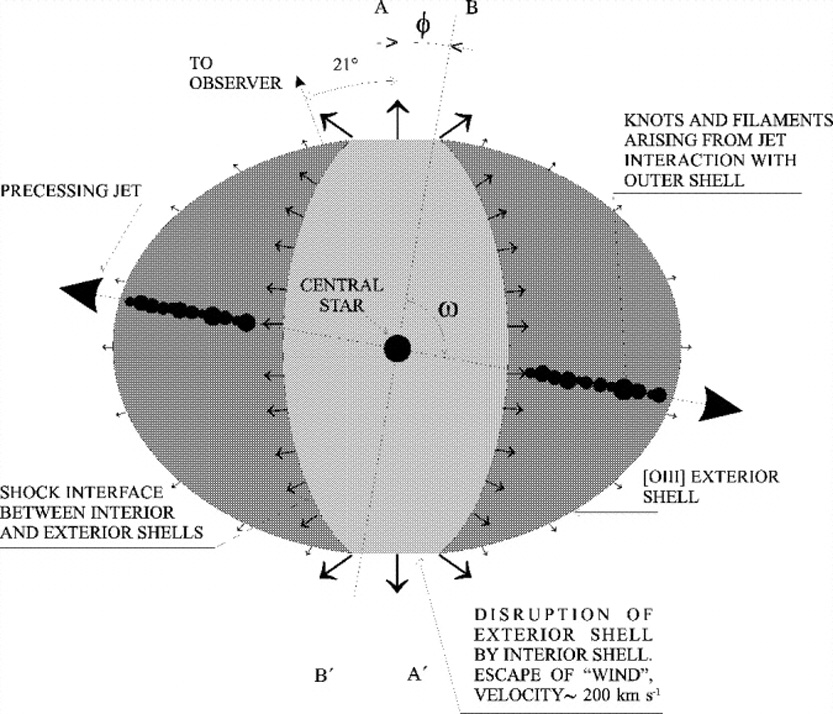
The multitude of forms assumed by planetary nebulae tells a story of mass loss and subsequent shaping by dynamical processes of the parent star. NGC 2392 is a bright, high excitation, young planetary nebula (PN) with a conspicuous double ring structure. to try In order to explain their puzzling shapes astronomers have attempted to create three dimensional models of PN's from two dimensional images with increasing success.
The general structure of NGC 2392 is that of a double shell with inner and outer components surrounding the central star HD 59088. The central star is an O-type dwarf with a surface temperature of 40,000 degrees Kelvin and is about 40 times more luminous than our sun. The inner shell is a watermelon shaped prolate spheroid with its long axis pointed close to the observer's line of sight. The gases within the inner shell are superheated to temperatures up to 2 million degrees causing the emission of high energy x-rays. The inner shell is enveloped by an outer shell in the shape of an oblate spheroid (slightly flattened sphere) with its long axis roughly perpendicular to the long axis of the inner shell. The inner shell is a young structure that is expanding along its short axis at about 30 kilometers per second. It is probably less then a thousand years old. The outer shell is composed predominantly of OIII (doubly ionized oxygen) with an age slightly more than 5000 years old. The inner shell is expanding at a more rapid pace than the outer shell (90 vs. 16 kilometers per second) and it appears that it is already breaking through the outer shell. The inner shell will completely overrun the outer envelope in a little over 5000 years.
Adding to the complexity of the nebula structure is the presence of a bi-directional jet arising from the parent star. Many planetary nebulae are known to emit fast collimated outflows in the form of jets (at velocities up to 1000 kilometers per second) in addition to their fast stellar winds. We are viewing the jet coming directly at our line of sight which produces the highly symmetric pattern of emission we observe in NGC 2392. Both the inner and outer shells contain thin disks (inner and outer disks) of nebula material. The comet shaped filaments projected in the outer shell structure most likely lie in a thin plane in the outer disk. The cometary shaped filaments and knots likely formed through a shock interaction produced by the jets interaction with the more slowly expanding material in the outer shell. The knots, each several billion miles across (several times the size of our solar system), have comet shaped tails each 100 billion miles long which point towards the central star. The comet shaped structures are believed to be caused by the collision of two expanding gas fronts having different temperatures and densities. The collision causes the gaseous mixture to become unstable (Rayleigh-Taylor instability) resulting in the fragmentation and condensation of the gas into large droplets which we see as the "comet heads".
Most likely the dying star underwent two phases of mass loss. The first occurred during the extended red giant phase and the second occurred during an epoch of strong stellar winds. The outer disk represents equatorially concentrated mass lost over several thousand years from the equator of the dying star. This phase was followed by the strong stellar wind phase of the star as it heats up and photoionizes the inner shell and outer disk.

Chart from
THE STRUCTURE OF NGC 2392, J. P. PHILLIPS1
AND L. CUESTA2, THE ASTRONOMICAL JOURNAL, 118:2929-2939, 1999
December
© 1999. The American Astronomical Society.